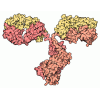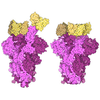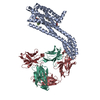+ Open data
Open data
- Basic information
Basic information
| Entry | Database: PDB / ID: 9pee | ||||||
|---|---|---|---|---|---|---|---|
| Title | Cryo-EM structure of CCR6 bound by PF-07054894 and OXM2 | ||||||
 Components Components |
| ||||||
 Keywords Keywords | MEMBRANE PROTEIN / GPCR / Complex / Antagonist | ||||||
| Function / homology | : / :  Function and homology information Function and homology information | ||||||
| Biological species |  Homo sapiens (human) Homo sapiens (human)synthetic construct (others) | ||||||
| Method | ELECTRON MICROSCOPY / single particle reconstruction / cryo EM / Resolution: 3.35 Å | ||||||
 Authors Authors | Wasilko, D.J. / Wu, H. | ||||||
| Funding support | 1items
| ||||||
 Citation Citation |  Journal: J Med Chem / Year: 2025 Journal: J Med Chem / Year: 2025Title: Discovery of PF-07054894, a Potent Squaramide-Based CCR6 Antagonist Displaying High CXCR2 Selectivity. Authors: Mark E Schnute / Huixian Wu / John I Trujillo / Wei Li / David Jonathan Wasilko / Jennifer Alley / Eric P Arnold / Scott W Bagley / Gabriel Berstein / David C Blakemore / Mark W Bundesmann / ...Authors: Mark E Schnute / Huixian Wu / John I Trujillo / Wei Li / David Jonathan Wasilko / Jennifer Alley / Eric P Arnold / Scott W Bagley / Gabriel Berstein / David C Blakemore / Mark W Bundesmann / Gary M Chinigo / Chulho Choi / Robert Cooke / Kimberly Crouse / Alpay Dermenci / Theresa Dickinson / Andrew Flick / Richard K Frisbie / Carmen Garcia-Irizarry / Brian S Gerstenberger / David Hepworth / Neelu Kaila / Daniel W Kung / Daniel Lamb / Sophie Y Lavergne / David C Limburg / Shenping Liu / Vincent M Lombardo / Prolay K Mondal / James J Mousseau / Arjun Narayanan / Nootaree Niljianskul / Philippe Nuhant / Senliang Pan / Michael J Primiano / Mathieu Rappas / Daniel C Schmitt / Stefanus J Steyn / Ray Unwalla / Dipy Vasa / Michael L Vazquez / Fabien Vincent / Xiaojing Yang / Atli Thorarensen /   Abstract: The G protein-coupled receptor (GPCR) CCR6 mediates the migration of pathogenic immune cells to the site of inflammation in response to the chemokine CCL20. CCR6 is an attractive target for the ...The G protein-coupled receptor (GPCR) CCR6 mediates the migration of pathogenic immune cells to the site of inflammation in response to the chemokine CCL20. CCR6 is an attractive target for the treatment of chronic autoimmune disease as antagonism of the receptor is expected to block CCL20-mediated immune cell recruitment. High-throughput-screening identified a squaramide-based, allosteric antagonist of CCR6 that potently inhibited CCL20-mediated T cell chemotaxis, but it also inhibited CXCL1-mediated neutrophil chemotaxis through CXCR2 antagonism. Lead optimization achieved differentiation from CXCR2 through identification of a methyl substituent-dependent selectivity switch or "magic methyl for selectivity". The mechanism for this effect is rooted in different antagonist-induced ligand-receptor behaviors, insurmountable for CCR6 and surmountable for CXCR2. Herein, we report the discovery and preclinical evaluation of the CCR6 antagonist PF-07054894 () which has advanced to clinical trials as a first in class approach targeting the receptor. | ||||||
| History |
|
- Structure visualization
Structure visualization
| Structure viewer | Molecule:  Molmil Molmil Jmol/JSmol Jmol/JSmol |
|---|
- Downloads & links
Downloads & links
- Download
Download
| PDBx/mmCIF format |  9pee.cif.gz 9pee.cif.gz | 198.4 KB | Display |  PDBx/mmCIF format PDBx/mmCIF format |
|---|---|---|---|---|
| PDB format |  pdb9pee.ent.gz pdb9pee.ent.gz | Display |  PDB format PDB format | |
| PDBx/mmJSON format |  9pee.json.gz 9pee.json.gz | Tree view |  PDBx/mmJSON format PDBx/mmJSON format | |
| Others |  Other downloads Other downloads |
-Validation report
| Summary document |  9pee_validation.pdf.gz 9pee_validation.pdf.gz | 1.7 MB | Display |  wwPDB validaton report wwPDB validaton report |
|---|---|---|---|---|
| Full document |  9pee_full_validation.pdf.gz 9pee_full_validation.pdf.gz | 1.7 MB | Display | |
| Data in XML |  9pee_validation.xml.gz 9pee_validation.xml.gz | 45.4 KB | Display | |
| Data in CIF |  9pee_validation.cif.gz 9pee_validation.cif.gz | 67.8 KB | Display | |
| Arichive directory |  https://data.pdbj.org/pub/pdb/validation_reports/pe/9pee https://data.pdbj.org/pub/pdb/validation_reports/pe/9pee ftp://data.pdbj.org/pub/pdb/validation_reports/pe/9pee ftp://data.pdbj.org/pub/pdb/validation_reports/pe/9pee | HTTPS FTP |
-Related structure data
| Related structure data |  71559MC M: map data used to model this data C: citing same article ( |
|---|---|
| Similar structure data | Similarity search - Function & homology  F&H Search F&H Search |
- Links
Links
- Assembly
Assembly
| Deposited unit | 
|
|---|---|
| 1 |
|
- Components
Components
-Protein , 1 types, 1 molecules A
| #1: Protein | Mass: 54623.020 Da / Num. of mol.: 1 Source method: isolated from a genetically manipulated source Source: (gene. exp.)  Homo sapiens (human) / Production host: Homo sapiens (human) / Production host:  |
|---|
-Antibody , 3 types, 3 molecules LKH
| #2: Antibody | Mass: 25343.348 Da / Num. of mol.: 1 Source method: isolated from a genetically manipulated source Source: (gene. exp.)  Homo sapiens (human) / Production host: Homo sapiens (human) / Production host:  |
|---|---|
| #3: Antibody | Mass: 15755.214 Da / Num. of mol.: 1 Source method: isolated from a genetically manipulated source Source: (gene. exp.) synthetic construct (others) / Production host:  |
| #4: Antibody | Mass: 28832.098 Da / Num. of mol.: 1 Source method: isolated from a genetically manipulated source Source: (gene. exp.)  Homo sapiens (human) / Production host: Homo sapiens (human) / Production host:  |
-Non-polymers , 2 types, 2 molecules
| #5: Chemical | ChemComp-A1A1W / Mass: 408.414 Da / Num. of mol.: 1 / Source method: obtained synthetically / Formula: C21H23F3N2O3 / Feature type: SUBJECT OF INVESTIGATION |
|---|---|
| #6: Chemical | ChemComp-A1CH1 / Mass: 466.533 Da / Num. of mol.: 1 / Source method: obtained synthetically / Formula: C24H30N6O4 / Feature type: SUBJECT OF INVESTIGATION |
-Details
| Has ligand of interest | Y |
|---|---|
| Has protein modification | Y |
-Experimental details
-Experiment
| Experiment | Method: ELECTRON MICROSCOPY |
|---|---|
| EM experiment | Aggregation state: PARTICLE / 3D reconstruction method: single particle reconstruction |
- Sample preparation
Sample preparation
| Component | Name: Complex of Human CCR6/PF-07054894/OXM2 with anti-BRIL Fab and anti-BRIL Fab Nanobody Type: COMPLEX / Entity ID: #1-#4 / Source: RECOMBINANT |
|---|---|
| Source (natural) | Organism:  Homo sapiens (human) Homo sapiens (human) |
| Source (recombinant) | Organism:  |
| Buffer solution | pH: 7.5 Details: 50 mM HEPES pH 7.5, 150 mM NaCl, 0.003% LMNG, 0.0003% CHS, 50 uM OXM2 and 50 uM of PF-07054894 |
| Specimen | Conc.: 1 mg/ml / Embedding applied: NO / Shadowing applied: NO / Staining applied: NO / Vitrification applied: YES Details: CCR6-BRIL/Fab/Nb complex co-purified with PF-07054894 and OXM2 |
| Specimen support | Grid material: GOLD / Grid mesh size: 200 divisions/in. / Grid type: Quantifoil R1.2/1.3 |
| Vitrification | Instrument: FEI VITROBOT MARK IV / Cryogen name: ETHANE / Humidity: 100 % / Chamber temperature: 277 K |
- Electron microscopy imaging
Electron microscopy imaging
| Experimental equipment |  Model: Titan Krios / Image courtesy: FEI Company |
|---|---|
| Microscopy | Model: TFS KRIOS |
| Electron gun | Electron source:  FIELD EMISSION GUN / Accelerating voltage: 300 kV / Illumination mode: FLOOD BEAM FIELD EMISSION GUN / Accelerating voltage: 300 kV / Illumination mode: FLOOD BEAM |
| Electron lens | Mode: BRIGHT FIELD / Nominal magnification: 165000 X / Nominal defocus max: 2200 nm / Nominal defocus min: 600 nm / Cs: 2.7 mm / C2 aperture diameter: 100 µm |
| Image recording | Electron dose: 40 e/Å2 / Film or detector model: FEI FALCON IV (4k x 4k) |
| EM imaging optics | Energyfilter name: TFS Selectris / Energyfilter slit width: 10 eV |
- Processing
Processing
| EM software |
| ||||||||||||||||||||||||
|---|---|---|---|---|---|---|---|---|---|---|---|---|---|---|---|---|---|---|---|---|---|---|---|---|---|
| CTF correction | Type: PHASE FLIPPING AND AMPLITUDE CORRECTION | ||||||||||||||||||||||||
| 3D reconstruction | Resolution: 3.35 Å / Resolution method: FSC 0.143 CUT-OFF / Num. of particles: 250839 / Algorithm: FOURIER SPACE / Num. of class averages: 1 / Symmetry type: POINT | ||||||||||||||||||||||||
| Atomic model building | Protocol: RIGID BODY FIT | ||||||||||||||||||||||||
| Atomic model building | PDB-ID: 9D3E Accession code: 9D3E / Source name: PDB / Type: experimental model | ||||||||||||||||||||||||
| Refinement | Highest resolution: 3.35 Å Stereochemistry target values: REAL-SPACE (WEIGHTED MAP SUM AT ATOM CENTERS) | ||||||||||||||||||||||||
| Refine LS restraints |
|
 Movie
Movie Controller
Controller



 PDBj
PDBj


